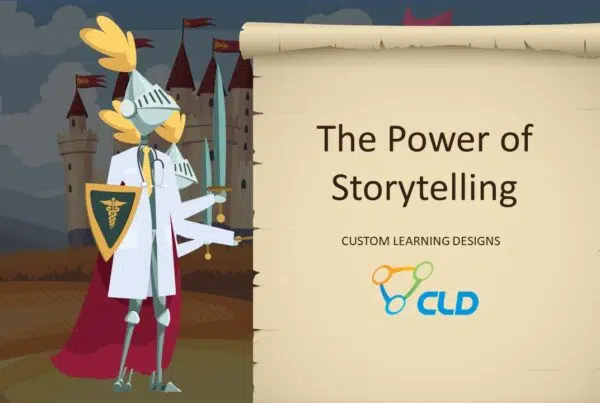When you first learn one of the major disciplines say physics, you often start from first principles. For example, if you want to learn to calculate how much force it would take to push a car down a hill, you might begin with a uniform block on a slope and evaluate the forces that act upon it. Starting from the very beginning is necessary when either the subject matter is brand new, or when the student is brand new to learning – like when kindergarten students learn individual letters before learning words.
But going back to first principles is not usually necessary for adult learning, particularly for professionals like pharma sales reps who come to the job with extensive education and often sales experience as well. In fact, rehashing things they already know can be detrimental to learning, causing trainees to tune out.
Engage Learners With Goals
Adult learning is more self-directed than childhood learning because adults are used to making choices relevant to their learning goals. In fact, trainers should incorporate goal-setting into the adult learning process, and trainees themselves must assume responsibility for setting and meeting them.
Grown-ups naturally use their existing knowledge and life experiences to reach new conclusions. The trainer who understands how to help students draw upon their own experiences and knowledge base will be more successful than the one who merely presents the information devoid of context. Adult learning must also be relevant. They don’t usually want to take the time to learn something that won’t be relevant to their goals, and they want an element of practicality in their lessons, to make them stick.
Engaging and Inspiring Adult Learners
Learners want to acquire and apply new knowledge, but they also want to be able to answer the question, “What’s in it for me?” Therefore, trainers must answer that question, either overtly or implicitly. If your group of trainees doesn’t think their learning sessions will add to their ability to do their jobs more effectively, then what motivation do they have for taking in, digesting, and assimilating the new concepts?
Immediate feedback is another way to engage and inspire adult learners, because it makes the learning experience more powerful. This is one reason why gamification has been such a terrific learning tool. It allows learners to make mistakes in a game environment, get feedback, and try again quickly. Feedback, of course, isn’t limited to gamified learning modules and should be an integral part of all your learning activities.
Sales Training Strategies Built on a Four-Dimensional Framework
Psychological researchers at Regis University created a four-dimensional framework for enhancing adult learning. It’s called the Motivational Framework for Culturally Responsive Teaching, and emphasizes how creating a motivational learning environment for adults in which content stays with them is built upon:
- Inclusion
- Attitude
- Meaning
- Competence
When training is built upon this framework, learners not only learn well and retain new knowledge, they are motivated to share it with others, which is excellent for in-class collaboration. Inclusion is a sense of community within a learning group, and building a learning community can take time and effort. But inclusion doesn’t just make everyone feel welcome, it confers a cognitive advantage on learners.
It’s OK to Tap into Emotions
Since inclusion and community are so important to adult learning, it stands to reason that tapping into emotion can be effective as well. When people feel an emotional connection to subject matter, they engage better with training materials and they’re more likely to absorb and retain information.
Powerful narratives are great at reaching learners on an emotional level, and relevant images and graphics can help learners emotionally connect with the material. The inclusion of positive emotional elements in sales training leads to more inspired, motivated learners, who feel connected to the learning environment. Humans are “wired” to respond to storytelling, and when it is woven into the training process, it allows learners to make an emotional connection that causes the material to stay with them.
Real-World Benefits of Sales Training Must Be Evident
Adult learners are generally practical. They’re engaging in training probably because they’re required to attend training, but also because they’re promised real benefits from it. Similarly to the “What’s in it for me?” sentiment, the “When am I going to use this information?” mindset is strong with adult learners. Make clear how the new information will help them improve work performance.
Show learners how the new product specs will influence how they relate to doctors, nurses, and pharmacists in their sales territory, and explain how the new mobile content system will make it easier to reach busy clients by allowing them to access critical information exactly when they need it. And when you’re developing training materials, think about how to present them so that learners can see how they help them fulfill learning objectives and improve on-the-job performance.
Cognitive Overload Can Undo Good Training
One thing adult and child learners have in common is that they can experience cognitive overload. The human brain can only hold so much information in short-term memory before it has to unload previous information to make room for more. Breaking learning content into smaller chunks can help learners avoid cognitive overload.
Trainers often find that designing learning modules focused upon specific, self-contained subjects and helping learners interweave that contained information in with what they bring to the learning environment helps with content absorption and retention. Putting your trainees in a room and bombarding them with masses of information is far less effective as a training technique than breaking it up and making it more digestible.
In the world of pharmaceutical sales, your learners arrive in the training environment with a substantial body of existing knowledge. That’s great because it means you don’t have to spend too much time reviewing information and can step right in with new material. Engaging and inspiring adult learners by tapping into emotions, making clear how new information will improve their performance, and dividing learning into smaller modules to avoid cognitive overload will help you reach trainees effectively so the training will fulfill the goals you and they set for it. Please feel free to browse through our free resources for sales trainers for additional ideas and inspiration on making your training programs engaging and effective.






